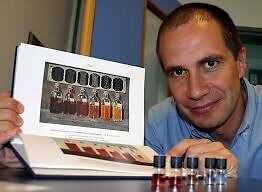Bioanalytics using single plasmonic nanostructures

Date
Location
Description
Speaker: Dr. Wolfgang Fritzsche
Nano Biophotonics Department, Leibniz Institute of Photonic Technology (IPHT)
Title: Bioanalytics using single plasmonic nanostructures
Abstract:
Novel requirements for bioanalytical methods emerge due to trends such as personalized medicine or on-site pathogen detection in environment and food. Here, innovative tools for diagnostics are needed, to be used outside of dedicated laboratories with less qualified personnel under minimal costs. Here the use of individual nanostructures (such as gold nanoparticles) for the detection and manipulation of biomolecules (e.g. DNA) based on optical approaches is presented [1].
The change in LSPR of individual metal nanoparticles is utilized to monitor the binding of DNA directly or via DNA-DNA interaction. The influence of different size (length) as well as position (distance to the particle surface) is thereby studied [2] using a dark-field approach developed a century ago [3]. The influence of molecular layers on the signal in LSPR is compared with the traditional propagating SPR technology [4]. The established serial approach has been further developed into a parallel readout using imaging spectrometric sensing based on interferometry and Fourier transformation [5]. So a parallelization of the assay is realized, which enables a much higher throughput for bioanalytical applications. For miniaturization and integration of such sensors, a electrical excitation would be helpful, overcoming the need for a light source and the respective optical setup. A generation of surface plasmons based on the quantum shot noise of tunneling current is utilized for biosensing using gap modes between gold nanoparticles and a metal film [6].
Besides sensing, individual plasmonic nanostructures can be also used to optically manipulate biomolecular structures such as DNA. Attached particles can be used for local destruction or cutting as well as coupling of energy into (and guiding along) the molecular structure upon laser irradiation [7]. The resonance wavelength of these particles can not only manipulated by their inherent properties (material, geometry) or their surrounding, but also by coupling with adjacent metal films due to interferometric effects [8] or gap modes.
- A. Csaki, T. Schneider, J. Wirth, N. Jahr, A. Steinbrück, O. Stranik, F. Garwe, R. Müller and W. Fritzsche, Philosophical Transactions A 369, 3483-3496 (2011).
- T. Schneider, N. Jahr, A. Csaki, O. Stranik and W. Fritzsche, J Nanopart Res 15, 1531 (2013)
- T. Mappes, N. Jahr, A. Csaki, N. Vogler, J. Popp, W. Fritzsche. Angew Chem Int Ed 51, 11208-11212 (2012)
- J. Jatschka, A. Dathe, A. Csaki, W. Fritzsche, O. Stranik. Sensing and BioSensing Research 7, 62-70 (2016)
- D. Zopf, J. Jatschka, A. Dathe, W. Fritzsche, O. Stranik. Biosensors and Bioelectronics 2016 81, 287-293 (2016)
- A. Dathe, M. Ziegler, U. Hübner, W. Fritzsche, A. Stranik. Nano Letters (in revision)
- A. Csaki, F. Garwe, A. Steinbrück, G. Maubach, G. Festag, A. Weise, I. Riemann, K. König and W. Fritzsche, Nano Letters 7 (2), 247-253 (2007); J. Wirth, F. Garwe, G. Haehnel, A. Csaki, N. Jahr, O. Stranik, W. Paa and W. Fritzsche, Nano Letters 11 (4), 1505-1511 (2011).; J. Toppari, J. Wirth, F. Garwe, O. Stranik, A. Csaki, J. Bergmann, W. Paa, W. Fritzsche, ACS Nano 7, 1291-1298 (2013); J. Wirth, F. Garwe, J. Bergmann, W. Paa, A. Csaki, O. Stranik, W. Fritzsche. Nano Letters 14, 570-577 (2014)
- J. Wirth, F. Garwe, R. Mayer, A. Csaki, O. Stranik, W. Fritzsche: Nano Letters 14, 3809-3816 (2014)
Subscribe to the OIST Calendar: Right-click to download, then open in your calendar application.



